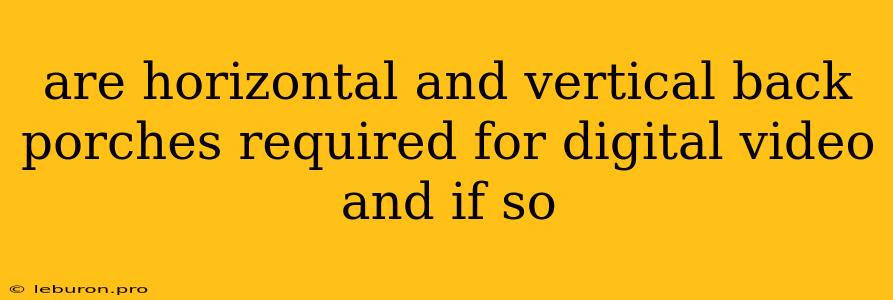The world of digital video is filled with complex terms and technical details, and one that often causes confusion is the concept of back porches. While you might hear these terms thrown around in discussions about video signals, understanding what they mean and why they are essential is crucial for anyone working with digital video. This article will delve into the world of back porches, explaining what they are, why they are necessary, and how they differ between horizontal and vertical signals. We'll also explore their relevance in the context of digital video and how they impact overall video quality.
Understanding Back Porches in Digital Video
In the realm of digital video, back porches are specific areas within a video signal that provide crucial timing information and control the overall synchronization of the video data. Imagine a video signal like a train track - the video data itself is like the train, and the back porches are the spaces between the tracks that ensure the train stays on course.
Horizontal Back Porch:
The horizontal back porch refers to the inactive period that follows the active video portion of each horizontal line in a video signal. This space is crucial because it allows time for the electron beam in a CRT monitor (or the pixels in a digital display) to return to its starting position, preparing for the next line of video data. Without this horizontal back porch, the image would be blurred, with lines bleeding into each other.
Vertical Back Porch:
The vertical back porch, similarly, is the inactive period that occurs at the end of each video frame, after the last horizontal line. It allows time for the electron beam to retrace to the top of the screen, preparing for the next frame of video data. This vertical back porch ensures a smooth transition between frames, preventing tearing or flickering in the image.
Why Are Back Porches Necessary?
Back porches are fundamental for several reasons:
- Synchronization: They act as timing references, ensuring proper synchronization between the video signal and the display device.
- Image Quality: They prevent image artifacts, such as blurring, tearing, and flickering, by allowing the electron beam or pixels to reset and prepare for the next line or frame.
- Data Integrity: They provide a buffer between the active video data and the blanking periods, ensuring that the signal transitions smoothly and that no data is lost.
- Compatibility: They are defined in video standards (such as NTSC, PAL, and ATSC), guaranteeing compatibility between different devices and ensuring consistent image quality across different platforms.
Horizontal and Vertical Back Porches in Digital Video:
In the digital video world, both horizontal and vertical back porches are essential for maintaining image integrity. They are defined within specific video standards, ensuring that all devices adhere to the same timing and synchronization protocols.
- Horizontal back porches: These are crucial for ensuring that each horizontal line of video data is displayed correctly and that the transitions between lines are smooth.
- Vertical back porches: These ensure proper synchronization between frames, preventing tearing and flickering that can occur when the frame rate is not correctly aligned with the display refresh rate.
Impact of Back Porches on Video Quality:
The proper implementation of back porches directly impacts the quality of the final video image. If the back porches are too short, it can result in:
- Blurring: Lines may not be displayed clearly, causing the image to appear fuzzy.
- Tearing: Frames may not be displayed completely, leading to vertical tearing artifacts in the image.
- Flickering: The display may not refresh smoothly, leading to a flickering effect.
On the other hand, if the back porches are too long, it can lead to unnecessary delays in the signal and potentially impact the overall timing of the video data.
Conclusion:
Horizontal and vertical back porches are essential components of digital video signals. These inactive areas provide vital timing information and synchronization protocols that ensure smooth and artifact-free video playback. While they might not be directly visible, their impact on overall image quality and the seamless playback of video is undeniable. Understanding the importance of back porches is crucial for anyone working with digital video, ensuring that the final product is clear, crisp, and enjoyable to watch.
